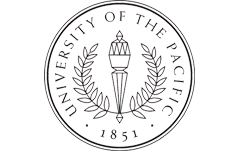Title
Synthesis and Purification of Tripeptides
Faculty Mentor Name
Jianhua Ren
Faculty Mentor Department
Chemistry
Graduate Student Mentor Name
Ashleigh Ramos
Abstract/Artist Statement
Introduction
Peptides are short chains of amino acids and many of them possess critical biological functions. Based on all their natural functionalities, peptides play a significant role in pharmaceutical products and have therapeutic potential for major diseases like cancer, cardiovascular disease, or some neurological disorders. The synthesis and purification of peptides resembling the active site motif of proteins are essential to understanding protein dysfunction. In this study, peptide synthesis was carried out, and the product’s structure and reactivity were analyzed. As an introductory study of peptide synthesis, a simple tripeptide strand, Ac-Cys-Gly-Ala--NH2, was synthesized with Rink amide resin in the laboratory. In this project, each peptide took approximately 3 weeks to be completely synthesized, purified, and analyzed.
Methods
In solid phase peptide synthesis (SPPS), rink amide resin was used as a structural support to form peptide bonds between amino acids from the C to N terminus. Using 20% Piperidine in dimethylformamide (DMF) as deprotection, fluorenylmethyloxycarbonyl (F-moc) was removed from the N-terminus of an amino acid to allow subsequent amino acids to attach. Washing using methanol (MeOH), dichloromethane (DCM), and DMF to removed unreacted reagents. During coupling, diisopropylethylamine (DIPEA), hexafluorophosphate benzotriazole tetramethyl uronium (HBTU), and DMF activated the new amino acid, preparing for linkage to another amino acid. The first three steps were repeated until the desired peptide was synthesized. In order to synthesize a tripeptide, coupling was completed three times. The original resin was split into two vessels. In one vessel, only cleavage was done. In the other vessel, N-terminal acetylation was done prior to cleavage. Acetylation replaced the N terminal amine with an acetyl group while cleavage removed the F-moc protecting group and the peptide from the solid support. The product’s purity was analyzed by mass spectrometry.
Results
After 3 weeks, the peptide Ac-Cys-Gly-Ala--NH2 was successfully synthesized in the laboratory. It is a complicated process involving many detailed steps. Mass spectrometry analysis revealed the purity and conformed the correct sequence of the peptide.
Synthesis and Purification of Tripeptides
Introduction
Peptides are short chains of amino acids and many of them possess critical biological functions. Based on all their natural functionalities, peptides play a significant role in pharmaceutical products and have therapeutic potential for major diseases like cancer, cardiovascular disease, or some neurological disorders. The synthesis and purification of peptides resembling the active site motif of proteins are essential to understanding protein dysfunction. In this study, peptide synthesis was carried out, and the product’s structure and reactivity were analyzed. As an introductory study of peptide synthesis, a simple tripeptide strand, Ac-Cys-Gly-Ala--NH2, was synthesized with Rink amide resin in the laboratory. In this project, each peptide took approximately 3 weeks to be completely synthesized, purified, and analyzed.
Methods
In solid phase peptide synthesis (SPPS), rink amide resin was used as a structural support to form peptide bonds between amino acids from the C to N terminus. Using 20% Piperidine in dimethylformamide (DMF) as deprotection, fluorenylmethyloxycarbonyl (F-moc) was removed from the N-terminus of an amino acid to allow subsequent amino acids to attach. Washing using methanol (MeOH), dichloromethane (DCM), and DMF to removed unreacted reagents. During coupling, diisopropylethylamine (DIPEA), hexafluorophosphate benzotriazole tetramethyl uronium (HBTU), and DMF activated the new amino acid, preparing for linkage to another amino acid. The first three steps were repeated until the desired peptide was synthesized. In order to synthesize a tripeptide, coupling was completed three times. The original resin was split into two vessels. In one vessel, only cleavage was done. In the other vessel, N-terminal acetylation was done prior to cleavage. Acetylation replaced the N terminal amine with an acetyl group while cleavage removed the F-moc protecting group and the peptide from the solid support. The product’s purity was analyzed by mass spectrometry.
Results
After 3 weeks, the peptide Ac-Cys-Gly-Ala--NH2 was successfully synthesized in the laboratory. It is a complicated process involving many detailed steps. Mass spectrometry analysis revealed the purity and conformed the correct sequence of the peptide.


